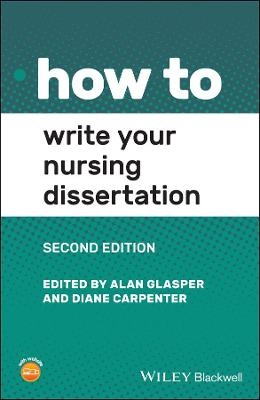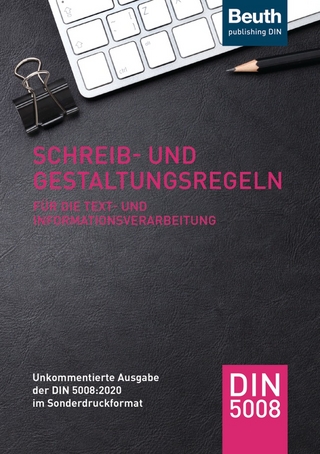
How to Write Your Nursing Dissertation
Wiley-Blackwell (Verlag)
978-1-119-75773-3 (ISBN)
Now in its second edition, this bestselling guide presents relatable and engaging scenarios to illustrate the setting of standards, explore legal and ethical frameworks, examine auditing and benchmarking, and demonstrate how evidence is applied to real-world problems. Covering the entire dissertation, project or evidence-informed decision-making assignment process from a nursing and healthcare perspective, this innovative textbook:
Helps students develop and appropriately answer a clear dissertation, project or evidence-informed decision-making assignment
Addresses the fundamental aspects of evidence-based practice in an accessible and readable style
Features new and updated content on mini dissertations, final assessments, and evidence-informed decision-making projects that many healthcare institutions now require
Presents up-to-date information that meets the needs of new healthcare roles, such as the Nursing Associate and Healthcare Assistant
Includes access to a companion website containing downloadable information, an unabridged dissertation sample, and links to additional resources
How to Write Your Nursing Dissertation is a must-have guide for nursing and healthcare students, trainees, other healthcare students required to complete an evidence-based practice project, and anyone looking to strengthen their critical appraisal and assignment writing skills.
ALAN GLASPER is Emeritus Professor of Nursing Studies, University of Southampton, UK. He is also the editor-in-chief of the international journal Comprehensive Child and Adolescent Nursing. DIANE CARPENTER is Lecturer in Mental Health Nursing, School of Nursing and Midwifery, Faculty of Health and Human Sciences, University of Plymouth, UK.
List of contributors xiii
Foreword xvii
Preface xx
About the companion website xxii
The Scenarios xxiiii
Section 1 Starting your dissertation journey 1
1 Starting the journey of your final-year project 3
Megan Bonner-Janes
What is a final-year project? 3
Why do nurses need to do a research-based project? 5
Undergraduate versus postgraduate projects 6
What are the features of a degree education? 7
Features of a final-year project 8
Planning your final-year project: essential considerations 9
Completing your final-year project and gaining a good classification 11
Don’t panic! 13
2 Introduction to writing your evidence-based practice dissertation/project 14
Alan Glasper, and Diane Carpenter
Sample guidelines for students undertaking a nursing associate project, an undergraduate healthcare project/dissertation or a master’s degree project 14
Typical learning outcomes for a nursing associate course 2000-word literature review 15
Typical learning outcomes for an undergraduate evidence-based practice dissertation/project 15
Typical learning outcomes for a postgraduate evidence-based practice dissertation/project 16
The dissertation/project/assignment 17
Guidelines for students undertaking a nursing associate evidence-based practice assignment 18
Guidelines for students undertaking an undergraduate evidence-based practice final project 19
Guidelines for students undertaking an undergraduate evidence-based practice dissertation 20
Guidelines for a typical postgraduate evidence-based practice dissertation/project module learning outcomes 22
Conclusion 23
3 Clinical effectiveness and evidence-based practice: background and history 24
Mary O’Toole and Alan Glasper
Introduction 24
Historical aspects of evidence-based practice 25
The contribution of the nursing profession to evidence-based practice 27
How is evidence sourced? 27
Conclusion 29
4 What is evidence-based practice and clinical effectiveness? 31
Andrée le May
Clinical effectiveness 31
Evidence-based practice 35
Making care more effective 38
5 The challenges of delivering practice based on best evidence (in primary, secondary and tertiary settings) 43
Andrée le May
An evidence base for practice 43
Barriers to the use of research evidence in practice 45
Encouraging the use of research evidence in practice 48
Conclusion 53
Section 2 Sourcing and accessing evidence for your dissertation 57
6 Sourcing the best evidence 59
Diane Carpenter and Alan Glasper
Exploring and refining your question 59
Searching for research articles 62
Devising your search strategy 66
Accessing journal literature 69
The Cochrane Library 70
Websites and other resources 74
Support from your library service 75
Conclusion 78
7 What is grey literature and where can it be found? 80
Diane Carpenter and Alan Glasper
What is ‘grey literature’? 80
Where can I find grey literature? 81
Important websites 82
What about Google scholar? 82
8 Harvard or Vancouver: getting it right all the time 83
Diane Carpenter and Alan Glasper
Vancouver system 84
Harvard system 85
Use of computer referencing packages 87
Conclusion 88
9 Posing an evidence-based practice question: using the PICO and SPICE models 89
Alan Glasper and Diane Carpenter
What is the PICO model? 90
Examples of PICO formulated questions 91
What is the SPICE model? 94
Section 3 Developing your healthcare/evidence-based practice dissertation 97
10 Managing your time wisely 99
Diane Carpenter and Alan Glasper
An evidence-based practice healthcare dissertation/final project or evidence-informed decision-making assignment as a frame of mind 100
Conclusion 104
11 Developing your study skills 106
Diane Carpenter, and Alan Glasper
Knowing yourself 108
Being organised 111
Organising things in terms of what goes where 112
Consolidating your ideas and activities by talking to others about it 112
12 Getting the most from your personal tutor 114
Ellen Kitson-Reynolds
Before approaching your academic support 114
How to get started 115
Agreeing a working pattern 116
Anticipating and preventing problems 116
Good planning is the essence 117
Supervision at a distance 118
Additional support 118
Section 4 Preparing to use research evidence in your dissertation 121
13 Clinical standards, audit and inspection 123
Diane Carpenter and Alan Glasper
What is healthcare governance? 124
What are the seven pillars of clinical governance? Are they still relevant in contemporary practice? 126
The role of the Care Quality Commission 127
NICE quality standards 132
Developing audit tools to measure compliance to policy standards 136
Healthcare regulators 139
Responding to an adverse incident 143
14 Understanding quantitative research 146
Diane Carpenter and Alan Glasper
Is it a quantitative study? 146
Why quantitative? 148
Types of quantitative studies 148
Key elements in a quantitative study 151
Strengths of quantitative studies 154
Limitations 154
Conclusion 154
15 Understanding qualitative research 156
Diane Carpenter and Alan Glasper
Why qualitative? 157
Types of qualitative studies 158
Key elements in a qualitative study 159
Strengths of qualitative studies 160
Limitations 162
Conclusion 163
16 Using historical literature 164
Diane Carpenter and Alan Glasper
What is the use of history in a world focused on scientific evidence? 165
Where does historical research fit methodologically? 165
Would such a study constitute primary research or would it be possible to appraise historical research that others had done? 167
Could I possibly justify doing a historical evidence‐based practice project? 168
How do I go about undertaking a study based on historical evidence? 168
Section 5 Critically appraising evidence 175
17 Selecting and using appraisal tools: how to interrogate research papers 177
Diane Carpenter and Alan Glasper
Introduction 177
What is critical appraisal? What are critical appraisal tools? Why is critical appraisal of published research important? What does critical appraisal mean to nurses and other healthcare professionals? 178
What is the best critical appraisal tool to use? 179
Commencing your critique 180
Is an individual paper worth adding to the shortlist? Preparing your initial long shortlist 181
Commencing your initial read and review of an empirical journal paper 181
Points to consider about the paper(s) before using any critiquing tool 183
Applying a critiquing framework tool of your choice to your selected papers 185
Critiquing models 187
Conclusion 196
18 Critically reviewing qualitative papers using a CASP critiquing tool 199
Diane Carpenter and Alan Glasper
Screening questions 200
The CASP qualitative questions 201
Data analysis 204
Research findings 204
The value of the research 205
Reflection 205
19 Critically reviewing quantitative papers using a CASP critiquing tool 207
Diane Carpenter and Alan Glasper
Question 1 ‘Did the study ask a clearly focused question?’ 208
Question 2 ‘Was this a randomised controlled trial and was it appropriately so?’ 209
Question 3 ‘Were participants appropriately allocated to intervention and control groups?’ 211
Question 4 ‘Were participants, staff and study personnel “blind” to participants study group?’ 211
Question 5 ‘Were all the participants who entered the trial accounted for at its conclusion?’ 213
Question 6 ‘Were the participants in all groups followed up and data collected in the same way?’ 213
Question 7 ‘Did the study have enough participants to minimise the play of chance?’ 213
Question 8 ‘How are the results presented and what is the main result?’ 214
Question 9 ‘How precise are these results?’ 215
Question 10 ‘Were all important outcomes considered so the results can be applied?’ 215
20 Critically reviewing a journal paper using the Parahoo model 217
Diane Carpenter and Alan Glasper
Introduction 217
Framework for appraisal 218
Conclusion 228
Section 6 Taking your dissertation further: disseminating evidence, knowledge transfer; writing as a professional skill 231
21 Publishing your work or making a conference or poster presentation 233
Diane Carpenter and Alan Glasper
Your dissertation or final assignment is complete: what next? 233
Motivation 234
Conference poster or abstract and presentation at a conference 235
Writing a paper for publication 241
What will you do with your evidence-based practice healthcare dissertation/final project or evidence-informed decision-making assignment? 247
22 Reflecting on your evidence-based practice healthcare dissertation/final project or evidence-informed decision-making assignment journey 248
Justine Barksby
Reflection 248
Frameworks for reflection 250
Some final points on reflection 256
Conclusion 257
23 Building the architecture of your dissertation 258
Diane Carpenter and Alan Glasper
Writing your evidence‐based practice healthcare dissertation/final project or evidence‐informed decision‐making assignment 258
Section 7 Bonus chapters (website only) 265
24 Public health: writing a master’s level dissertation
Sarah Adrienne Hughes
25 Critically reviewing a journal paper using the Rees model
Diane Carpenter and Colin Rees
26 Managing a learning difference
Michelle Cowen
27 Research governance in practice
Jane March-McDonald
28 Using evidence in practice
Index 267
| Erscheinungsdatum | 05.10.2020 |
|---|---|
| Reihe/Serie | How To |
| Verlagsort | Hoboken |
| Sprache | englisch |
| Maße | 140 x 216 mm |
| Gewicht | 431 g |
| Themenwelt | Geisteswissenschaften ► Sprach- / Literaturwissenschaft ► Literaturwissenschaft |
| Medizin / Pharmazie ► Pflege | |
| Technik | |
| ISBN-10 | 1-119-75773-8 / 1119757738 |
| ISBN-13 | 978-1-119-75773-3 / 9781119757733 |
| Zustand | Neuware |
| Informationen gemäß Produktsicherheitsverordnung (GPSR) | |
| Haben Sie eine Frage zum Produkt? |
aus dem Bereich


